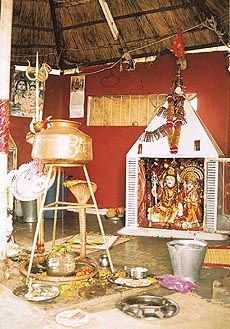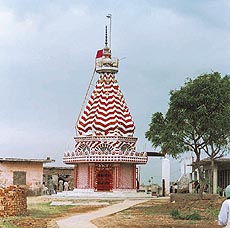A tale of two
temples
By Randeep
Wadehra & Amarnath Wadehra
THE Shiva temple atop a hill in
Chandimandir is a source of divine solace to many a
disturbed soul. The serenity that one experiences by
panoramic view atop the hill is inexpressible. One has to
experience it to believe it. Since it has not yet been
commercialised, the idyllic surroundings are just what
the tormented city dweller needs to rejuvenate his
despondent spirits. But, for how long will the place
remain safe from the march of civilisation?
 Swami Rajeshwar Dayal Giri, the
temple priest, claims that Shiva temple is a few thousand
years old. The swami, who is a graduate from KU came in
1962 to Chandigarh to take part in a swimming
competition. He came in contact with Swami Narayan Giri
and sought his blessings for doing well in his studies.
In 1966, he again met Narayan Giri, this time to seek his
blessings for rising in politics. This time, however, he
was initiated into the Giri sect, instead! In 1972, in
deference to his Guru Narayan Giri’s wishes,
Rajeshwar Dayal became an ascetic and came over to look
after the shrine. Swami Rajeshwar Dayal Giri, the
temple priest, claims that Shiva temple is a few thousand
years old. The swami, who is a graduate from KU came in
1962 to Chandigarh to take part in a swimming
competition. He came in contact with Swami Narayan Giri
and sought his blessings for doing well in his studies.
In 1966, he again met Narayan Giri, this time to seek his
blessings for rising in politics. This time, however, he
was initiated into the Giri sect, instead! In 1972, in
deference to his Guru Narayan Giri’s wishes,
Rajeshwar Dayal became an ascetic and came over to look
after the shrine.
The swami says that
decades back the locals believed that there was a Shiva
temple on the hill-top, but the police and forest
officials did not allow people to gain access to the
area. The site was covered with bushes, stones and dust,
yet the locals firmly believed in the temple’s
existence. Consequently, a suit was filed to get access
to the site. Under the court’s orders, the place was
dug up and, much to the chagrin of government officials,
ancient statues of Lord Shiva were excavated from the
site. The police, however, allegedly took away the
statues by force and hid them.
They also appealed in
the Punjab and Haryana High Court against the lower
court’s orders. During the proceedings, however the
statues were recovered. The High Court upheld the verdict
that there was sufficient evidence to prove the existence
of a temple there.
 The swami has filed a suit for
defilement of the statues, which is still sub judice.
With the help of public contributions, a small Shiva
temple was constructed atop the hill. A Hanuman temple
too has come up at the bottom of the hill. Here, langar
is organised daily. A pucca path has been laid
from the Hanuman temple to the Shiva temple. The swami has filed a suit for
defilement of the statues, which is still sub judice.
With the help of public contributions, a small Shiva
temple was constructed atop the hill. A Hanuman temple
too has come up at the bottom of the hill. Here, langar
is organised daily. A pucca path has been laid
from the Hanuman temple to the Shiva temple.
There is an interesting
story about the origin of the Hanuman temple. There was a
root of a Banyan tree at the site. Devotees would adorn
it with sindoor, with a firm belief that the act
would help them gain their cherished boons. It is
believed that when Lakshmana fell unconscious and Hanuman
went to the Himalayas to fetch the sanjeevani booti,
he had momentarily stopped here on the way back, thus
sanctifying the place. It is also believed that the
Pandava princes did tapasya here. Lord Shiva appeared
before them and told them to build a Chandi temple at the
site. Hence, the place came to be known as Chandimandir.
The road to these
temples is kutcha. There is a regular stream of
devotees to these temples. On Shivaratri, devotees come
in thousands to seek the blessings of Shiva. The
committee looking after the two temples plans to develop
the place into a full-fledged teerth-sthal.
Personally, one would prefer the place to retain its
sublime tranquillity.
|

![]()

